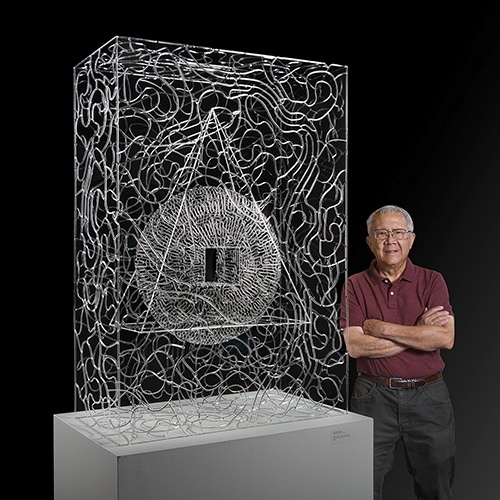
Refracting Brilliance: The Glass Artistry of Brent Kee Young
Brent Kee Young is a luminary in contemporary glass art, celebrated as a master craftsman, innovative artist, and dedicated educator. As Professor Emeritus at the Cleveland Institute of Art, his influence extends far beyond the classroom, reaching prestigious museums, galleries, and collections across the United States and Asia. His latest creation, “Cascade,” set to debut at Seattle-Tacoma International Airport, further solidifies his status as a preeminent figure in the field.
Throughout his career, Young has consistently demonstrated a remarkable ability to innovate in the field of glass art. From his early Fossil Series, featured in the Smithsonian American Art Museum’s Renwick Gallery, to his groundbreaking Matrix Series, also included in the Renwick, Young’s work captivates audiences with technical brilliance and creative depth. The Matrix Series, in particular, highlights his mastery of flameworked borosilicate glass rods, creating intricate, web-like structures that challenge traditional views of glass art.
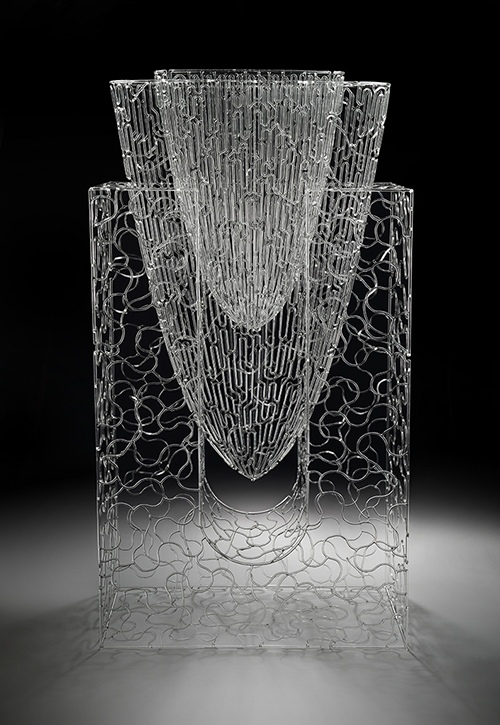
Central to Young’s artistry is a refined combination of industrial craftsmanship and organic fluidity, achieved through intricate design and meticulous attention to detail. His transparent glass creations harness light and shadow, crafting a mesmerizing interplay between substance and space. The flowing, neural-like patterns evoke a sense of movement and interconnectedness, while the forms themselves strike a delicate balance between strength and fragility. This harmonious contrast invites contemplation on the convergence of natural and artificial realms, seamlessly blending rigidity with fluidity, the tangible with the ethereal. The intricate complexity of Young’s work resonates with the interconnected nature of our world, reflecting patterns found in natural phenomena, human cognition, and artistic expression.
His distinctive approach has garnered numerous accolades, including the Ohio Arts Council’s Individual Excellence Award, establishing him as a key figure in both the American and International Studio Glass Movements. In a recent in-depth conversation, Young shared unparalleled insights into his creative process, philosophy, and the progression of his remarkable career, offering a deeper appreciation of the passion, skill, and creativity that define his extraordinary contribution to the art of glass. Brent Kee Young’s work continues to shape the landscape of contemporary glass art and inspire emerging artists worldwide, further underscoring his influence and legacy in the field.

Q: Your Matrix Series showcases intricate, web-like structures made from flameworked borosilicate glass rods. What inspired you to develop this unique technique and focus on these complex forms?
A: The Matrix series emerged from my dedication to experimentation, a principle I strongly emphasize in my teaching philosophy. I believe it’s essential for artists to continually experiment throughout their careers, not just during the initial learning stages.
Inspiration for this series came from various sources in nature and my surroundings. I observed glints of light defining form in nature, patterns created by schooling sardines, and even a pile of rebar from a demolished building next to my studio. I initially considered welding that rebar into a cube-shaped outdoor sculpture, which sparked the idea to create something similar in glass.
Around 2002, I created the first piece in this style – a hemisphere with a negative cubic space inside, about 16-18 inches in diameter. This was my first venture into using borosilicate glass but I had been flameworking since the 70’s with the Fossil Series. When I exhibited this piece in a faculty show, it generated significant curiosity due to its stark difference from my previous work.
Encouraged by this response, I pursued this direction and held my first Matrix series show in the Washington, DC area in 2004. At that point, I decided to focus entirely on this technique, setting aside my blown glass work and other methods.
To help people visualize the concept, I often use the example of a tumbleweed cut into a cube and then imagined in glass. This gives an idea of the intricate, web-like structures I create with glass rods.
It’s worth noting that I developed this technique through experimentation, not through formal workshops or training. This approach of learning through doing has been consistent throughout my career, including when I developed my casting techniques. I believe this experimental approach is crucial for artistic growth and innovation.
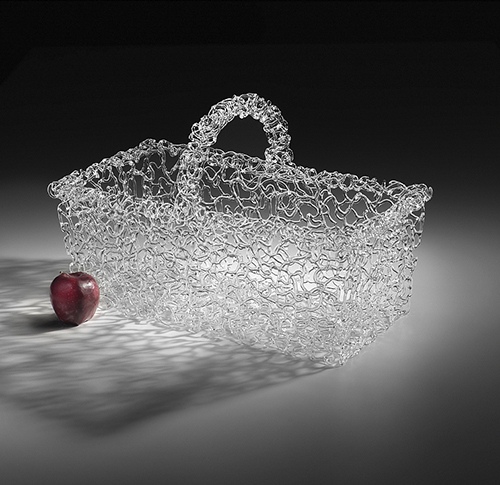
Q: How did you choose the subject matter for your glass sculptures?
A: My subject matter often comes from objects that catch my interest in various settings. For instance, I might see an intriguing basket form at an art museum or as early in my career at street fair in San Francisco’s China Town, I created a piece based on a vegetable basket I saw.
Many of my objects are loosely inspired by folk art or other interesting forms I encounter. I use these as starting points to learn how to create new shapes in glass. It’s a way to honor these traditional forms by presenting them in a different, more intricate medium.
I also work with more geometric shapes like cubes, spheres, ellipses and arches, which create a different kind of visual dialogue. These forms allow me to explore various artistic compositions and expressions within the same technique.
The process is incredibly labor-intensive, though not necessarily highly technical. It’s similar welding in mid-air, joining glass elements with T-shaped connections. Each curve and each connection is carefully bent and joined, almost like drawing in three-dimensional space with glass rods.
The intricate nature of the work is part of its appeal. It transforms familiar objects into something extraordinary through the detailed process of glass rod manipulation.
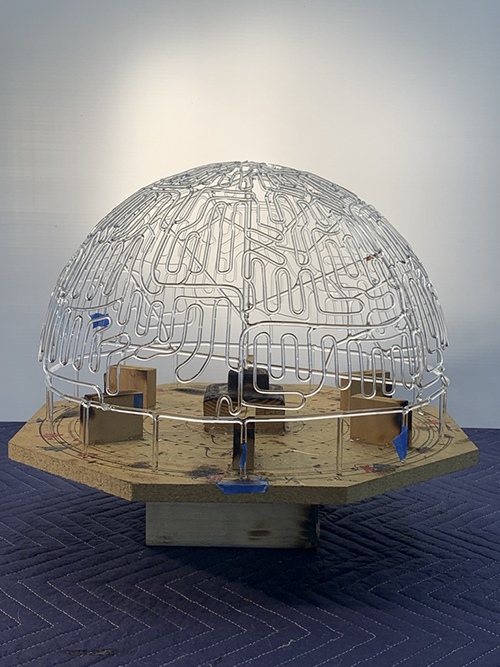
Q: Can you walk us through your creative process for the Matrix Series? How do you approach the design and construction of such intricate pieces?
A: My process almost always begins with a schematic drawing, a plan for the piece. For shapes like spheres, I use a concept called volumes of solid revolution, where a circle line is rotated around an axis. I build a glass armature that, when turned, forms a hemisphere, guiding the sequence of my work.
I often create a glass substructure, a kind of scaffolding, to work over. This gives me guidance and sometimes becomes part of the final piece. The physical act of welding isn’t the most challenging part; the difficulty lies in designing the approach to building the shape. It’s similar to architecture in that way.
My background in engineering helps me design these different base forms. The pieces aren’t constructed as a single unit initially, but rather in sections – perhaps as many as seven, eight or more separate parts that are later assembled to create the whole.
The aesthetic I aim for has both a chaotic atmosphere and a structural integrity. This duality helps draw the audience in and engage with the work while also showcasing the material’s properties.
Despite their delicate appearance, these pieces are surprisingly sturdy. They’re strong enough to be handled, moved, and shipped across the country to galleries and museums. While they would break if mishandled, they’re much more robust than they appear due to the nature of borosilicate glass and their matrix structure. The network of many small elements joined together creates a structurally sound piece that’s stronger than it looks, though obviously not as solid as a solid ball of glass.
This balance of apparent delicacy and actual strength is part of what makes these pieces intriguing.

Q: Your play on light in the Matrix series makes the sculptures very beautiful. Can you tell us more about this aspect of your work?
A: The interplay of light is an integral part of my design process. It’s crucial in defining the form of each piece. To illustrate this concept, imagine observing a vase or any volumetric shape – the way light interacts with it helps reveal its structure and form.
A beautiful example of this phenomenon can be seen at the Monterey Bay Aquarium. They have an exhibit with thousands of sardines, and as these fish swim around, the light reflecting off them creates a mesmerizing effect. What you see are segments of light, little glints that help define the overall form of the school. This is similar to what I’m aiming to achieve with my glass structures.
In my pieces, you don’t see the entire form illuminated at once. Instead, you perceive bits of light reflected at certain points, which helps define the overall shape. Some parts of the form you can see through, while others catch the light in intriguing ways.
The time of day and the light source’s position significantly influence how the piece appears. As you move around the sculpture, or as the light changes from sunrise to sunset, the form illuminates differently. This constant shift in appearance creates an ever-changing visual interest, inviting the viewer to engage with the piece from multiple angles and at different times.
This dynamic interaction between light, form, and viewer perspective is a key element in making these sculptures captivating and alive.
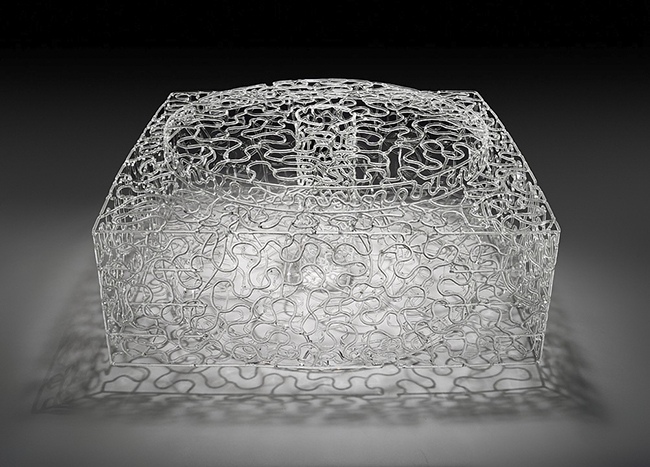
Q: Your work has been featured in publications like the “New Glass Review” and “50 Years of Studio Glass.” How do you see your role in the evolution of the studio glass movement over the past decades?
A: I see my role in the studio glass movement as somewhat of an outsider or contrarian. While much of popular glass art tends to be colorful and organic, my approach leans towards minimalism, which is quite singular in the glass world.
I often tell my students that glass can be its own worst enemy due to its inherent beauty and the joy of working with it. Glass blowing, for instance, is an amazing process that has evolved over centuries. However, my goal has been to use the material in a different way, bringing a new sensibility to it.
My minimalist approach is partly inspired by scientific methodology. By eliminating variables, in this case, color, I can focus more intently on form and structure. While I’ve experimented with color, I always seem to return to colorless work as it allows me to concentrate on what I’m trying to achieve without interference.
Over the past 50-60 years, the field has evolved from being controlled by the material to artists controlling the material. There’s still a divide between the decorative, fashion-like side of glass art and the more sculptural, art-focused side. As a craftsperson, I believe we can straddle both worlds.
While I’m not as enthralled with much of what’s popular in glass art, I appreciate its popularity as it has helped me present my ideas within the broader culture of craft. I see myself as part of the movement, but leaning more towards the sculptural side, which isn’t as popular as other approaches.
In essence, my role has been to push the boundaries of what glass art can be, moving away from typical forms to explore more minimalist, structural approaches. This contributes to the diversity and evolution of the studio glass movement by offering a different perspective on what glass art can achieve.
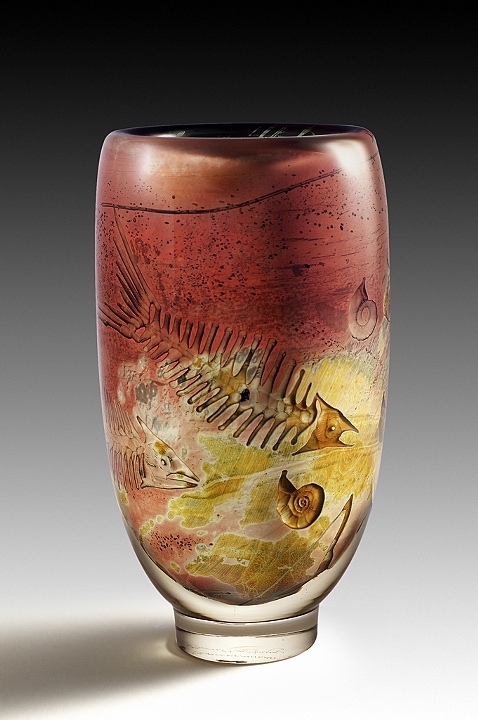
Q: Can you tell us about your educational background? What led you to switch from an engineering major to pursuing glass art?
A: My journey from engineering to glass art was quite a winding path. As a child, I loved making things with tinker toys and erector sets, which led me to initially pursue engineering in college. I started at a junior college for two years, then moved on to San Jose State finishing my lower division engineering courses. During this time, I was also working at a civil engineering firm in California.
However, I soon realized that the office work, primarily drafting, wasn’t fulfilling my desire to physically create things. A pivotal moment came when a high school friend, who was in the ceramics department, invited me to try throwing clay pots on a wheel. This hands-on experience was revolutionary for me.
That summer, I took classes at Oregon State, including clay and calligraphy. Around the same time, I visited an exhibition called “Objects USA” at the Oakland Art Museum, which showcased various crafts. The woodwork of Sam Maloof particularly impressed me, demonstrating that one could make a life out of physically creating beautiful objects.
Inspired, I returned to San Jose State and enrolled in ceramics courses. I continued working in engineering to finance my education, but my focus had shifted. I eventually completed my undergraduate degree in ceramics with a minor concentration in glass.
For graduate school, I initially applied to programs in ceramics but was offered a place in the new glass program at The New York State College of Ceramics at Alfred University. I accepted on the condition that I could minor in ceramic sculpture.
Interestingly, my engineering background, particularly in drawing, has proven valuable in my glass work. This blend of technical skill and artistic vision has shaped my unique approach to glass art.
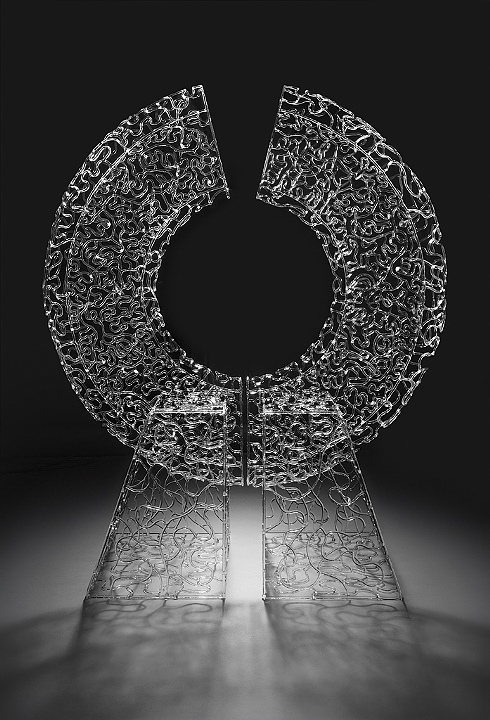
Q: Do you have any new exploration of themes that you are currently pursuing besides the Matrix series?
A: Currently, I’m not moving away from the Matrix concept, as I find it offers a versatile framework, much like architecture, allowing me to create a wide variety of objects within my aesthetic. Rather than seeking a revolutionary change, I’m focusing on evolving.
I tend to move back and forth from geometric composition to pieces with more of a narrative. For instance, I’ve only made two ladder pieces so far, and I’m curious to see what a third might look like. Recently, I completed a large geometric piece featuring an abstract Chinese coin motif—a round shape with a square hole—set within a pyramid inside a large cube. This piece represents my ongoing exploration of geometric forms.
Looking ahead, I’m planning to work more with geometric shapes while I’m waiting for new inspirations. One idea I’m considering involves creating alphabet block-like forms with spheres inside that will tumble rather than stack neatly, creating a sense of tension and imbalance.
My creative process involves a lot of thinking and drawing. Often, ideas come to me randomly, and I make sure to write them down to revisit later and see if they still resonate. Although my initial sketches are two-dimensional, my background in engineering allows me to think in three dimensions when planning. I use techniques like drawing front, top, side and orthographic views to visualize the complete form.
This approach of continual evolution within the Matrix framework, combined with my engineering background, allows me to keep exploring new possibilities without departing entirely from the core concept that has defined my work.
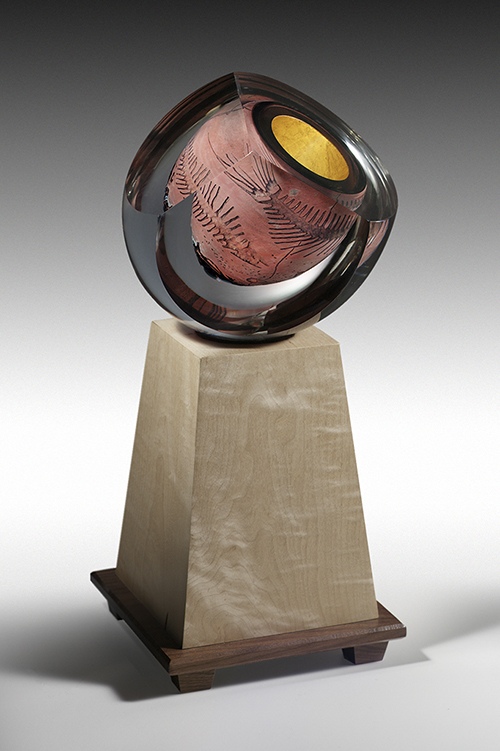
Q: How does working with borosilicate glass rods in the Matrix Series differ from the techniques you employed in your earlier Fossil Series?
A: The techniques and materials used in my Matrix Series are quite different from those in my earlier Fossil Series.
For the Fossil Series, I used what’s commonly known as Soda Lime glass, which is a type of glass typically used for blowing. This glass is softer and has a longer working range compared to the borosilicate glass rods I use in the Matrix Series. Soda lime glass wouldn’t be as suitable for creating the intricate structures I make in the Matrix pieces.
The process for creating the Fossil Series pieces was also quite different. I personally blew the glass for these works, usually with the help of an assistant due to the physical demands of handling large pieces of glass – some weighing up to 20 pounds. The imagery was flame worked in clear glass rods, that I previously made, and imbedded in the interior substrate during layering, creating the effect of a negative fossil like relief.
In contrast, the Matrix Series involves a more intricate, precise process of joining borosilicate glass rods. This glass has different properties that allow for the creation of the complex, web-like structures characteristic of the series.
The shift from the Fossil Series to the Matrix Series represents not just a change in aesthetic, but also a significant evolution in my technical approach to working with glass. It required me to develop new skills and techniques specific to working with borosilicate glass rods, moving away from traditional glass blowing to a more sculptural, construction-based approach.
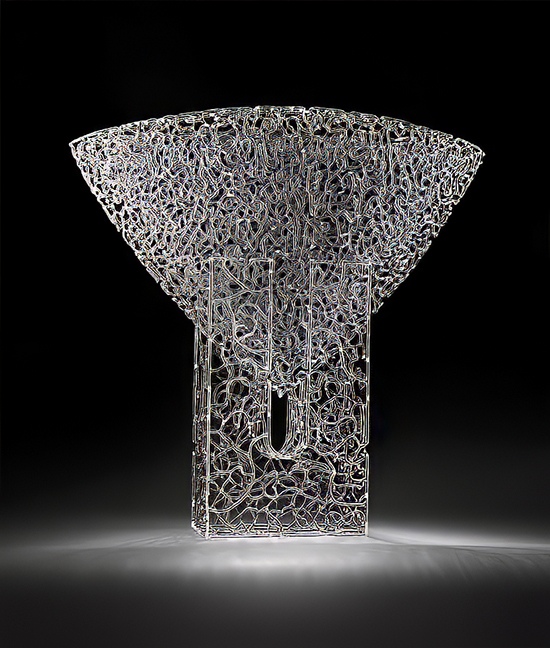
Q: Reflecting on your career, are there particular moments or achievements that stand out as defining or transformative for you?
A: Looking back on my 42-year teaching career, especially at the undergraduate level, there have been many defining moments. It’s incredibly rewarding to see students’ careers progress and to know I’ve played a part in their journey. There are many examples of former students who continue to grow and practice professionally, artists as well as teachers. One recent experience that stands out is receiving a call from a former student who’s now building a cold working shop in New York. Another is teaching in Finland.
A transformative moment from my early career occurred during my undergraduate studies in ceramics. I created a piece that combined the basic techniques I’d learned in clay with concepts from my background in civil engineering, particularly my interest in topography. When I took that piece out of the kiln, it was a seminal moment. It showed me that I could bring a unique, personal aesthetic to my work, drawing from my own background rather than imitating others.
Another pivotal moment came when I exhibited the first Matrix experiment in a faculty show. My colleague, painter Julian Stanczak, approached me with questions about the work, which was quite different from what I’d been doing before. His reaction, neither clearly positive nor negative, prompted me to really examine the piece and recognize the potential of this new direction.
My engineering studies and practice has been instrumental in shaping my approach. It’s given me a different perspective on the physics and chemistry of working with materials. This is evident even in my blown work, where the use of color often reflects a landscape-like quality.
These moments of experimentation, recognition, and synthesis of my diverse background have been crucial in defining my career and artistic voice. They’ve reinforced the value of bringing unique experiences and knowledge to one’s art practice, and the importance of being open to new directions and interpretations of one’s work.

Q: Your pieces often exhibit a delicate balance between fragility and strength. How do themes of vulnerability and resilience manifest in your art?
A: Rather than thinking about it as a balance, I see the interplay between fragility and strength as an inherent characteristic of my work, one that serves as a powerful tool to engage the audience. When people see a familiar object like a chair rendered in glass, it immediately draws them in. The recognition of the form, coupled with the unexpected material, creates an intriguing tension that invites closer examination.
My construction method is key to this effect. I’m not working with solid, massive forms, but rather with a network of smaller elements. This approach aligns with my aesthetic preference for minimalism within the matrix concept. Instead of using large, sturdy components, I opt for thinner, smaller elements. This choice isn’t about deliberately making the piece more delicate, but about staying true to the matrix aesthetic while challenging perceptions of strength and fragility.
A good example of this is my series of anvil pieces. Real anvils are massive, often weighing 175 pounds or more, made of forged steel to withstand intense force. In contrast, my glass anvils are constructed using a delicate network of glass rods. This juxtaposition of a traditionally robust object rendered in a seemingly fragile material challenges viewers to think differently about glass and its properties.
This approach manifests themes of vulnerability and resilience in a subtle way. The pieces appear delicate, perhaps even vulnerable, yet they possess an unexpected resilience due to their matrix structure. It’s not about creating a perfect balance between these qualities, but about using their interplay to engage viewers, challenge their expectations, and invite them to reconsider their perceptions of materials and forms.
By presenting familiar objects in this unexpected way, I’m encouraging viewers to contemplate the nature of strength and fragility, and how these concepts might apply beyond just the physical realm. It’s a way of making people think about glass differently, and by extension, to perhaps think differently about other aspects of their world as well.
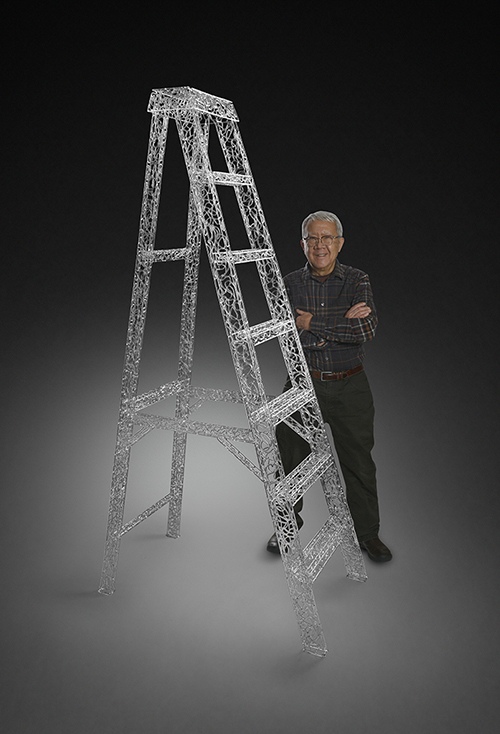
Q: Could you share the story behind your 2023 piece “Reach….”? What concepts or emotions were you exploring with this work?
A: With “Reach…,” I was more interested in posing questions rather than providing answers. The piece explores various concepts – there are references to climbing, to reaching for the ceiling, to the act of working. The title itself invites contemplation.
One of my main challenges was to create a freestanding ladder, as opposed to my previous ladder piece that leaned against a wall. I wanted this to have a presence in the middle of a space. Part of the process was simply figuring out if I could construct such a form.
The piece, like many of my works, draws from everyday objects. This accessibility is intentional – I want viewers to be able to relate to the object it represents. It’s iconic in that way, recognizable, allowing people to connect with it easily.
However, it also questions functionality – can this glass ladder actually function as a ladder? This contradiction between the familiar form and the unexpected material invites viewers to engage with the piece on multiple levels.
My geometric pieces, in contrast, are more about understanding form and have a different psychology to them. They’re interesting in a different way, more abstract and less immediately relatable.
In the end, pieces like “Reach…” are about creating a dialogue. I’m interested in what kind of questions people have when they see it. It’s meant to provoke thought and inspire curiosity rather than provide a definitive statement or answer.
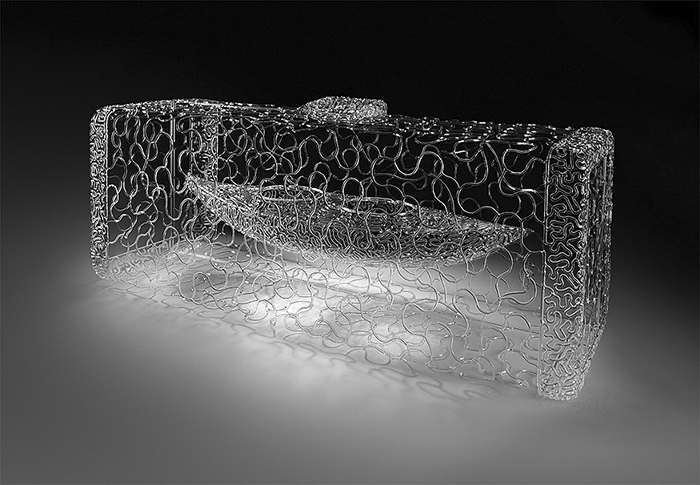
As our exploration of Brent Kee Young’s artistic odyssey concludes, we are left in awe of his profound impact on the world of glass art. From his innovative techniques to his thought-provoking creations, Young has consistently expanded the horizons of this challenging medium. His Matrix Series stands as a testament to his technical mastery and creative vision, while his legacy as an educator continues to inspire new generations of artists. Through our conversation with Young, we’ve gained invaluable insights into the mind of a true pioneer, understanding the dedication, experimentation, and artistic philosophy that have shaped his remarkable career. As Brent Kee Young continues to weave his luminous legacy, his work serves as a beacon for the future of glass art, illuminating new possibilities and challenging us to see the familiar world in extraordinary new ways.
Young’s Website